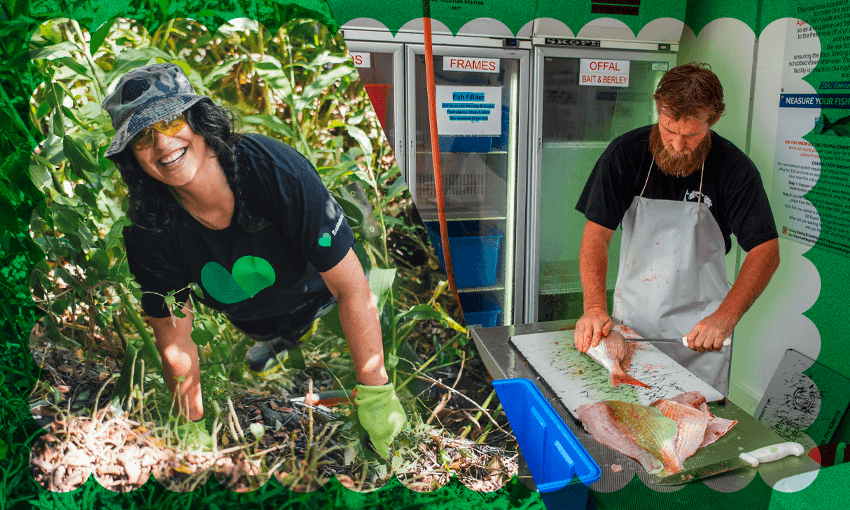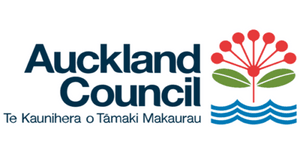Auckland may be the largest city in Aotearoa, but it’s the small community-led organisations within it that make the city thrive. The Spinoff spoke to two council-funded organisations who are doing their bit.
“Torrent.” That’s the word one 40-year resident of Dundale Avenue used to describe what became of the stream, then placidly gurgling a few metres from us, when the January 2023 floods wreaked havoc across Auckland. She had paused in her work – ripping up the English ivy blanketing the riverbanks, pulling out the tree privet that sprouted among it – to explain, one gloved hand resting on a dead branch, how that flooding sparked the chain of events that led to her being here on the bank of the Whau Stream, in the company of a dozen other volunteers, on a sunny Saturday morning over one year later.
After the floods, local residents approached then-MP Michael Wood about maintaining the waterway along the Whau Stream running adjacent to Blockhouse Bay’s Dundale Avenue. Wood engaged Auckland Council’s Healthy Waters, which in turn funded EcoMatters Environment Trust to coordinate the community in helping to care for the Whau Stream under the aegis of the council’s 10-year Making Space for Water programme.
Making Space for Water is a key investment priority under Auckland Council’s Long-term Plan proposal, which is currently out for public consultation. The programme is an integral part of the Long-term Plan, as it invests in infrastructure to strengthen Auckland’s resilience against flooding. The programme proposes seven operational initiatives including delivery of critical works, repair and rebuild to help build resilience for the stormwater network and reduce the impact of future flooding.
Before the floods, the Blockhouse Bay resident said, if one had wanted to help care for the stream, there was no communal action to join. That changed with EcoMatters’ involvement.
Auckland’s streams, explained EcoMatters’ Pamela Gill (Ngāti Porou, Te Aitanga-a-Hauiti) – when she wasn’t attacking a large wild ginger plant or advising volunteers on the difference between native houhere and invasive privet – are a vital aspect of our urban environment.
“Healthy, thriving streams are really important. They provide habitat for our native birds, bats and critters, trees and grasses – they are really important spaces. They can help fight climate change as well. Our urban forests are vital for helping to provide shade and absorb carbon.” And when it rains and the city’s drainage systems reach capacity, “an open stream can carry more water to the sea, which can help to reduce flooding. The water has to go somewhere. We all need to be thinking about where it’s going.”
It shouldn’t, Gill says, only be the responsibility of those at risk who need to do that thinking.
She motioned at the houses opposite, and the impermeable concrete driveways down which water cascades towards the stream in a downpour. “We’re all in this waka together.”
“We all need to be supporting the council and the wider community to care for our natural environment so that it can support us. I come back to that whakataukī from Whanganui: ko au te awa, ko te awa ko au: I am the river and the river is me.”
And, as Gill points out, what better body than the council – ideally the embodiment of the city’s collective will – to kick-start that communal mindset? The funding provided by the council makes this community action possible.
“We couldn’t have done it without Auckland Council. Many Aucklanders are wanting support to care for their streams, and we’ve really appreciated the council’s willingness to meet their needs, particularly around supporting community-led action.”
A similar nexus of community interests first breathed life into The Kai Ika Project, a collaboration between the Outboard Boating Club, LegaSea, Westhaven Marina and Papatūānuku Kōkiri Marae. It began in 2016 when the club approached LegaSea seeking ideas about what to do with the unwanted bits of fish left over at their onsite filleting stations. At the time the club was dumping them, but as LegaSea’s programme lead Sam Woolford explains, they knew they could “do better”. “We said, ‘Well, why don’t you give them to the marae?’”
Some cultures regard the fish head as something to be discarded; others consider it a delicacy. In te reo Māori, for example, the fish head is called rangatira kai, meaning “chiefs’ food”. Many other cultures also revere fish heads as something to be savoured, and the elegant simplicity of The Kai Ika Project lies in its ability to harness what is already one of Tāmaki Makaurau’s greatest strengths: the diversity of cultures that call it home.
“The beauty of Auckland and of being multicultural is what allows us to actually use the fish completely… I joke and say that for us fish heads are the fabric of our society,” Woolford says. With that guiding kaupapa in place, the programme began modestly, moving perhaps 250kg of kai moana a week. “It was one pickup a week, it was mainly just being used through the marae.”
When Covid-19 hit and uncertainty wove itself into our lives, demand exploded. Recreational fishing was obviously disallowed under the restrictions, but the essential service provided by commercial fisheries continued; Woolford “went out and made friends with them”. Another company Royal Wolf provided a container, Campbell Plumbing and local electricians chipped in to get the necessary infrastructure in place. “Over that first lockdown, we went from about 250kg a week to 1,250kg a week,” Woolford says. “We just scaled up massively, because the community needed support. What else are you going to do?” By the end of Auckland’s second big lockdown, “the queues were even longer”. At its peak, The Kai Ika Project was distributing 2,000kg of seafood every week.
It was in the midst of that rapid growth that Auckland Council became an integral partner, through regional grants within its Waste Minimisation and Innovation Fund.
“Suddenly, there was some quite large capital expenditure required,” he says. Vehicles, full-time employees: without additional funding, there was a ceiling to what The Kai Ika Project could achieve.
The investment of the council, Woolford says, allowed them to serve the grateful community. Once, he remembers, coming across a kuia at the marae who “just got up out of her wheelchair and gave me a big hug. Didn’t say a word. Stuff like that is powerful.”
But even so, Woolford says, The Kai Ika Project has never been able to keep up with demand, something that has only worsened as the cost-of-living crisis has followed on the heels of Covid. Current capacity sits at between 1,250 and 1,500kg a week.
In the interests of creating a self-funding model, Kai Ika operates a filleting station at Westhaven Marina, where you can get a fish filleted for three dollars, with the proceeds flowing back to cover distribution costs. And the programme has been expanded to Wellington, with interest growing in other regions too. There are cooking programmes, and Papatūānuku Kōkiri Marae will soon open a “koha café”, where a fish-based menu will be available for what people are able to pay. Everything, Woolford says, is done in the interests of becoming economically self-sufficient and “feeding more people”.
And they’ve already reached plenty of stomachs. The Kai Ika Project recently surpassed 400,000kg of fish that would’ve otherwise gone to landfill; what can’t be eaten is used to fertilise the approximately 80,000 kumara grown and given away by the marae every year. It has created what Woolford calls an entire “waste-recovery industry. There are jobs, now we employ people to do what didn’t exist five, six, seven years ago.”
And, as he says, it couldn’t have been done without the support of the council. “It’s their investment that’s allowed us to break those barriers down.”
What do you want from Auckland Council’s Long Term Plan and Waste Management and Minimisation Plan? To find out more information and have your say on key issues please visit akhaveyoursay.nz or your local council library or service centre by March 28.

